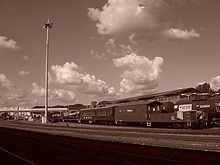Native name 동해남부선(東海南部線) Line length 143.2 km (89.0 mi) Stations 37 | Closed 30 December 2016 Operator Korail | |
 | ||
Opened Stages between 1918–1935 Owner Korea Rail Network Authority Locale | ||
donghae nambu line korea
The Donghae Nambu Line is a railway line connecting Busan to Pohang in South Korea. The line runs along South Korea's east coast. On December 30, 2016, it was merged into Donghae Line.
Contents
- donghae nambu line korea
- donghae nambu line pohang sta and section center of a city vanished
- History
- Upgrade
- BusanUlsan
- UlsanGyeongjuPohang
- Stations
- Services
- References
donghae nambu line pohang sta and section center of a city vanished
History
On October 31, 1918, an extension of the Daegu Line reached Pohang. The section from Gyeongju to Pohang would become the oldest part of the future Donghae Nambu Line. On October 25, 1921, a branch of the Daegu Line from Gyeongju to Ulsan (Taehwagang) was opened. On 16 December 1935 Busan and Ulsan were linked up through the opening of the section Jwacheon–Ulsan. The new line and the two older sections built as part of the Daegu Line were combined into the new Donghae Nambu Line, with a length of 145.8 km (90.6 mi) from Busanjin to Pohang.
Upgrade
As of 2010, most of the line remains single-track and unelectrified. The entire line is to be upgraded to an electrified-double-tracked railway.
Busan–Ulsan
Planning for the upgrading of the line started in 1990 already, with the primary aim to improve commuter traffic; construction started in June 2003. The section gets a new 72.1 km long alignment with several tunnels. Korea Rail Network Authority, Busan, and Ulsan city government is undertaking the upgrade. As of 2010, construction progress reached 32% of the total budget of 2,268.9 billion won. The completion of the upgrade is foreseen for 2015.
On September 1, 2010, the South Korean government announced a strategic plan to reduce travel times from Seoul to 95% of the country to under 2 hours by 2020. As part of the plan, the Busan–Ulsan section of the Donghae Nambu Line is to be further upgraded for 230 km/h.
Ulsan–Gyeongju–Pohang
The line is to be replaced by a completely new alignment that circumvents downtown Gyeongju and connects to the Gyeongbu High Speed Railway at Singyeongju Station. In 2003, a feasibility study was prepared for the section. Detailed design was started, and in May 2007, the government expected to realise the project from 2008 to 2011 at the earliest. The project was finally approved by the government on April 23, 2009, and a ground-breaking ceremony was held. The altogether 76.56 km line was slated to be opened in December 2014, with a total budget of 2,328.899 billion won. In January 2010, the early completion of the Pohang branch was confirmed by the government.
Stations
Major stations and junctions along the line include (in order):
Services
The line sees passenger and freight traffic. As of October 2010, from Bujeon Station in Busan, cross-country Mugunghwa-ho trains travel in around 1 hour 25 minutes to Ulsan and in around 2 hours 40 minutes to Pohang. Via the Gyeongbu, Daegu and Jungang Lines, Pohang and Ulsan are connected to Seoul with both intercity Saemaul-ho and cross-country Mugunghwa-ho services. As of 2010, the shortest travel times from Seoul to Pohang are around 5 hours 15 minutes by direct Saemaul service and around 3 hours 40 minutes with transfer to KTX trains at Dongdaegu.
After its upgrade is finished, the role of the line as a corridor for freight traffic will be enhanced.
